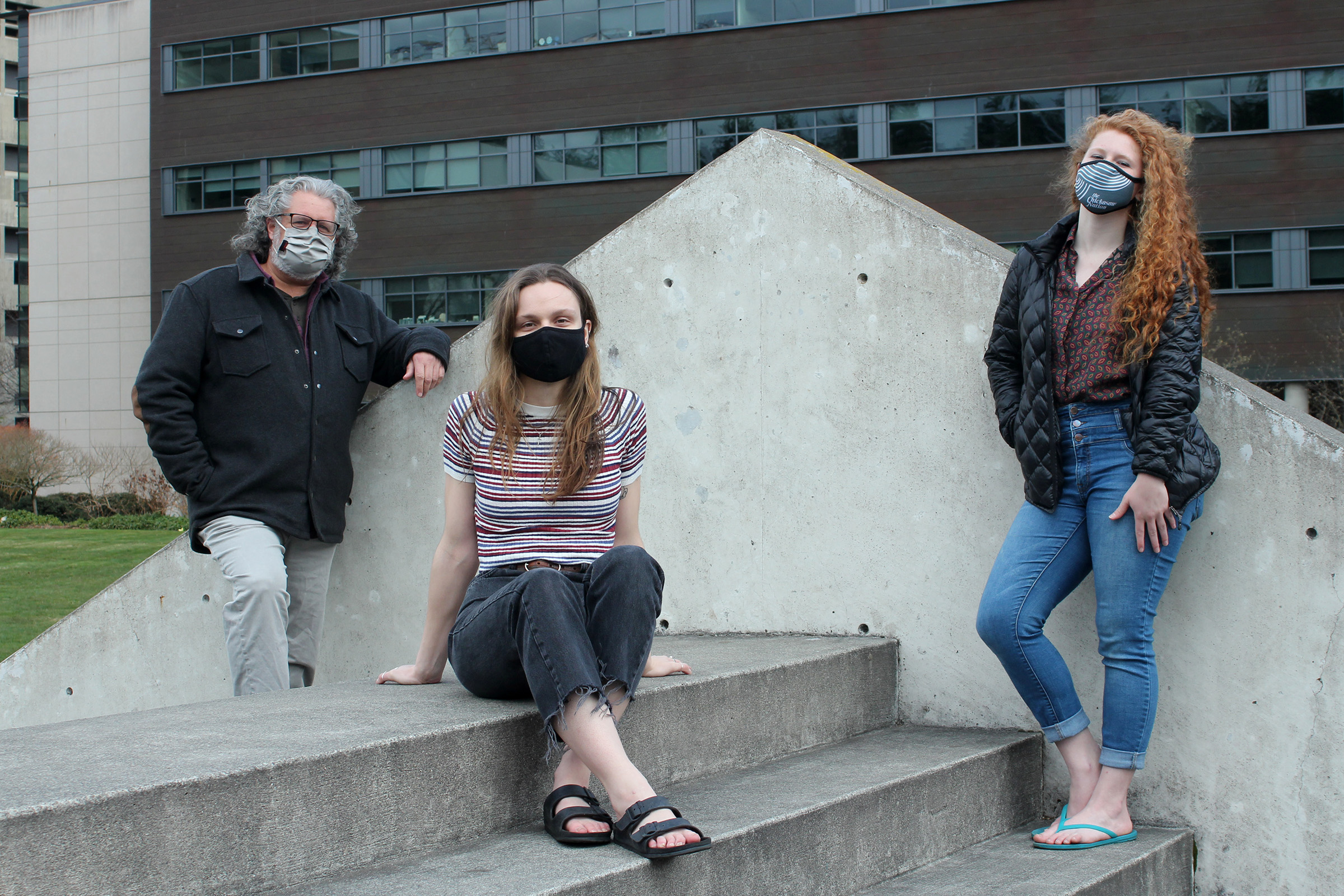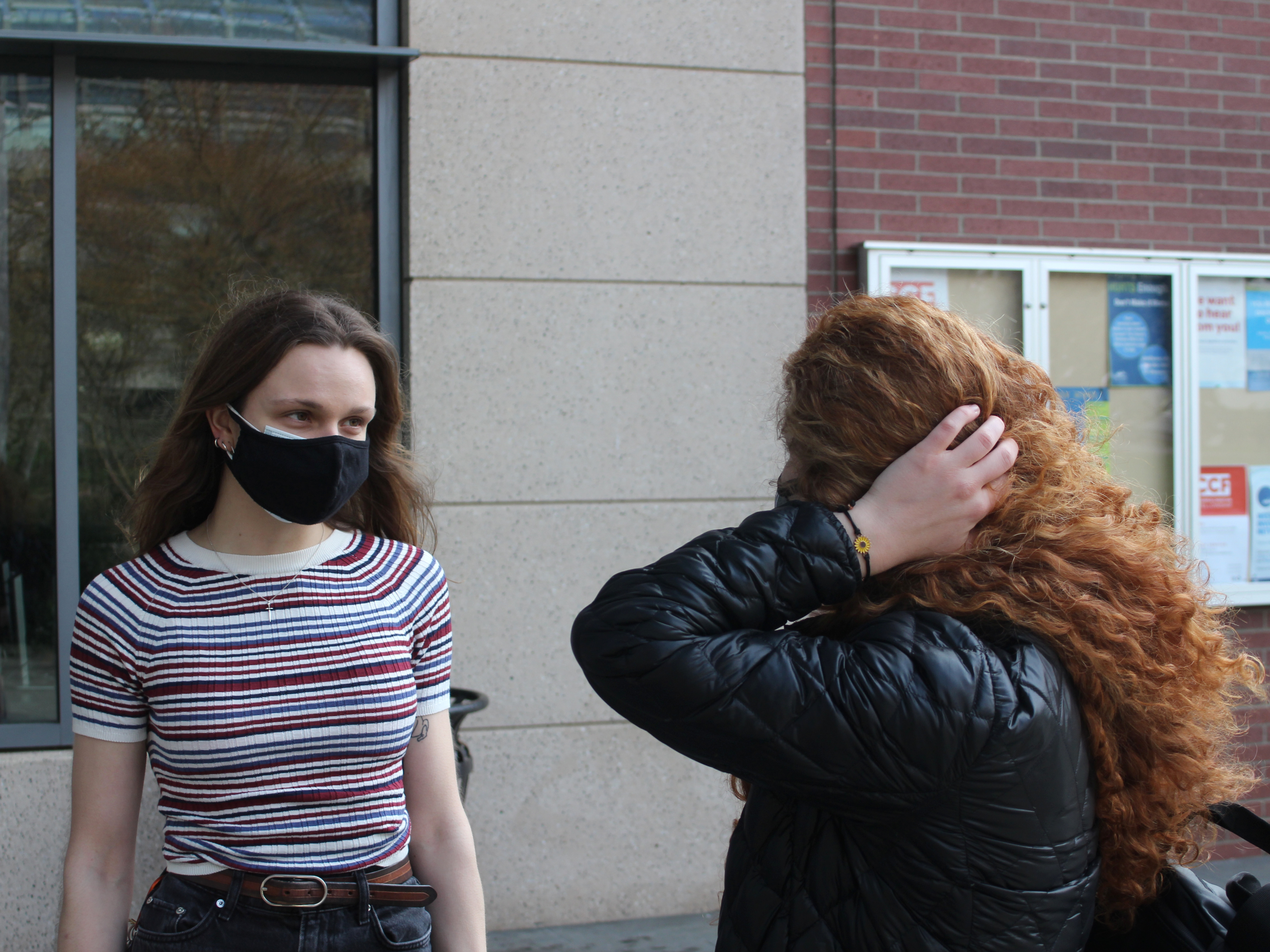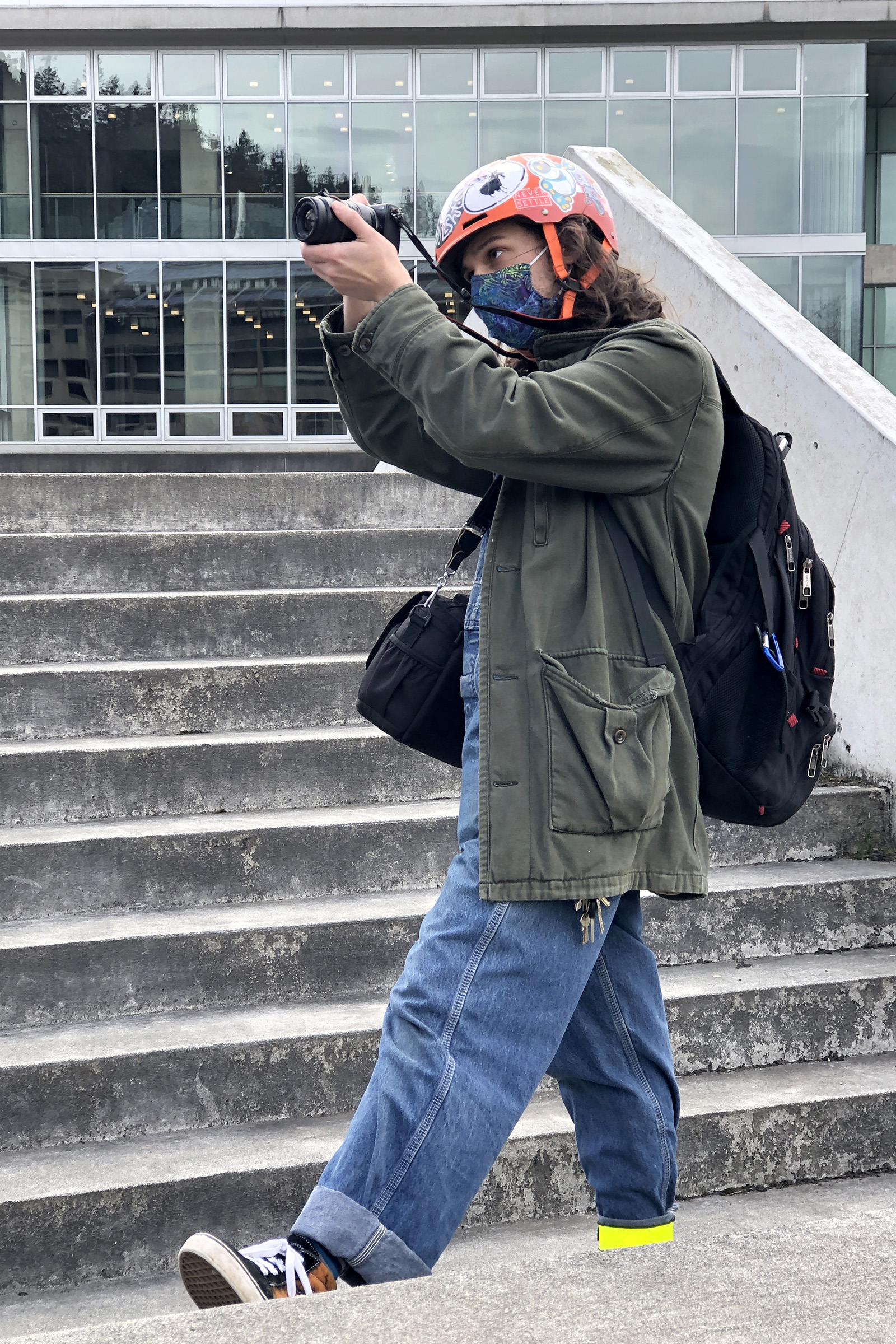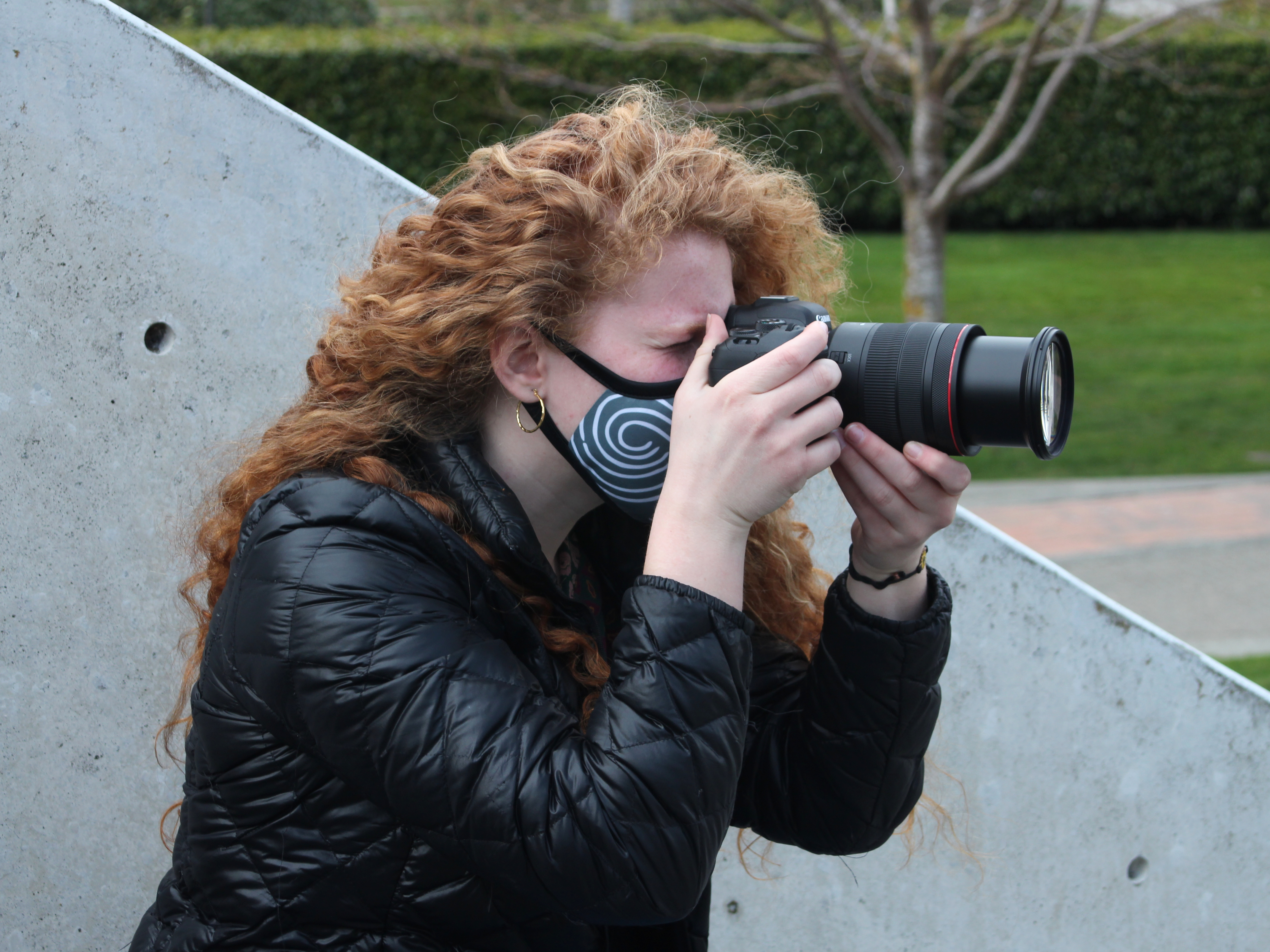More Than A Click Away

The challenges visual journalism students have faced in adapting to producing visual content remotely.
Story and photos by Garrett Rahn
I lift my head and slap at my phone, hoping to silence the incessant ringing of the 9:50 a.m. alarm. Eyes barely cracked, I reach over the side of my bed and pull up my laptop from where I left last night working on an assignment well past midnight.
Groggily, I click the link to join a Zoom meeting for my 10 o’clock class. I leave the camera off. I fall asleep again for the first ten minutes.
It’s unlikely I’ll find a reason to leave bed before noon.
For a lot of students, doing all of their schoolwork from home is a brand new experience. Finding motivation in the new work space can be tough.
Merredith McDowell, a senior at Western Washington University, says that before the pandemic she never did any of her schoolwork in her studio apartment, opting to work at school or in coffee shops instead.

“I just get distracted,” McDowell said. “I don’t even have a desk.”
McDowell is a Visual Journalism major, like me. The major has its own set of unique challenges when it comes to online learning. It focuses on preparing students to deliver news visually in the professional world, with skills like “photojournalism, information graphics, video and audio clips, mapping and typography.” The lack of in-person guidance over the last year for obtaining the specific techniques of the trade is creating obstacles for students that could affect us later in our careers.
One of the biggest hurdles is the lack of access to technology.
I remember taking JOUR 370, Digital Media in Journalism, during spring quarter when the lockdowns were first implemented. The class teaches students how to make documentary style journalistic videos, and a lot of it involves teaching students how to use the appropriate equipment and software — which mics work best in which situations, how to film interviews, how to navigate Adobe Premiere and many other best practices.
Getting gear from Academic Technology and User Services (ATUS) felt more like a drug deal than a tech loan. We meet outside. I put my ID on a cart and step back ten feet. An employee approaches the cart, swipes my card, puts the equipment on the cart, then backs away. I grab the bag and case and hastily speed out of there. It was weird, but at least I got a tripod and mic out of it.

A lot of other students did not have that luxury. Many returned home for remote classes and were stuck with the cameras and recording equipment available to them there, which for some meant just their smartphone.
Even once I had the gear, I didn’t have someone there to tell me how to use it. I remember for one of my interviews, I didn’t know how to turn on the mic properly and ended up recording one second of audio, missing the whole interview. Anything I did manage to record correctly, I still had very little to go on as to where to place the mic or how to make sure the levels were adjusted well.
Going into the pandemic, McDowell was using a 2015 Macbook. JOUR 346, Intro to Visual Journalism, required her to use a lot of processing- and memory-heavy Abode Suite applications, like Illustrator, Photoshop and Premiere. Her computer crashed constantly, or just refused to run the applications. Normally, she would just go to a Mac lab on campus, where the powerful desktop computers available there would have no trouble completing those tasks. But with the Wilson Library and Communications Facility Building closed to students, that was not an option for her.
McDowell feels as though she isn’t getting the education she is paying for, especially as a senior finishing up her last year of college.
“I feel like I’m going to graduate and just be like, ‘What the hell was that last year?’” McDowell said.
Tori Corkum, another student in the major, had the exact same issues as McDowell: an older computer that couldn’t handle the demands of Premiere.
“Every time I opened audio, it would just crash,” Corkum said.
Both Corkum and McDowell said that the only reason they were able to work through those issues was with the help and astute communication skills of the Intro to Visual Journalism professor, Joe Gosen.
“I love Joe so much,” Corkum said. “You can quote me on that.”
For every problem they experienced, Gosen was able to either help them through it or was understanding and flexible enough to let them turn in whatever they could with the limited tools available to them.
Gosen recognizes how much of a challenge it has been for students to learn these skills without the proper equipment, or having him be there to help in person.
“How do I teach someone in another part of the state how to set up LED lights when they don’t have them?” Gosen said. “How do I tell them to test out four different microphones when they don’t have them?”
Part of being a flexible educator is encouraging his students to find creative workarounds. Gosen encourages his students to work with their surroundings. Perhaps he’ll have them gather all of the desk lamps in their house to get lighting from multiple angles. If they don’t have a slider for filming, he’ll see if they can use a skateboard, or put the camera on a towel and drag it across the countertop.
Another challenge present with teaching visual journalism online is its lack of spontaneity that professors like Gosen typically thrive off of.
In a classroom setting, Gosen will have a solid outline for the lecture, but he relies on real-time interaction and questions from students to further advance the learning and deepen their comprehension. Try as he might, he can’t anticipate every question that students would normally ask in class to put into his recorded lectures.
Gosen likens his teaching style to playing an instrument. “There’s a big difference between playing live and recording,” Gosen said.

Corkum agrees that the lack of give and take has been detrimental.
“We don’t know what we don’t know,” Corkum said. “Someone else could ask a question, and I may not have thought of that question, but since they asked, I also want to know!”
For me, the lack of interaction with other students in the major has been particularly tough. Before reaching out for these interviews, I felt completely isolated in my experience. In a major so driven by deadlines, it’s easy to feel like you are falling behind, and when you can casually converse with someone experiencing the same thing as you, it helps to stave off the sense of dread and defeat.
Holden Predmore is relatively new to the major, having recently switched over from the News Editorial track. While they enjoy discourse and debate, they are a self described “solo learner,” and as such, adjusted well to learning on their own from home. But, being a recent transfer from Central Washington University and an even more recent VJ student, they feel like they didn’t make enough journalist friends before the lockdowns in which to express their opinions about the profession.
“I don’t have many people to talk about my education with,” Predmore said. “It would be nice to have met more people who I could talk about what I am learning and make friends who would care about that.”
For some of us, building those relationships has been difficult without in-person interaction. For Corkum, however, the computer screen presents less of an obstacle for connection.
“The only thing we have control over right now is our attitudes,” Corkum said.
Corkum wishes she could have done her classes in person, but feels that she has still had the chance to connect with others. She goes out of her way to reach out and make new friends, even over Zoom or Slack.
“You get out of an opportunity what you put into it,” Corkum said. “If you don’t reach out, you won’t make connections. You don’t have to be on all the time, but don’t be afraid to reach out, because chances are, people are feeling the exact same way as you.”
I can back that claim up with my own experience. After all, I had to reach out to write this.
Really, it hasn’t been a total waste of a year, even if it kind of felt like it. As visual journalists, we are more creative now. We spent our time learning the ins and outs of the limited equipment available to us. We made some of our most stirring work, and we did it all in our sweatpants.
I am a better journalist now then I was when this all started. What more I could ask for?
